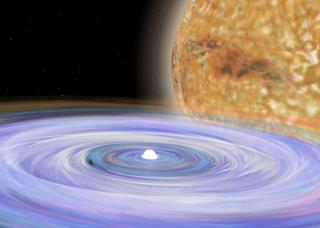Bibcode
Burdge, Kevin B.; Prince, Thomas A.; Fuller, Jim; Kaplan, David L.; Marsh, Thomas R.; Tremblay, Pier-Emmanuel; Zhuang, Zhuyun; Bellm, Eric C.; Caiazzo, Ilaria; Coughlin, Michael W.; Dhillon, Vik S.; Gaensicke, Boris; Rodríguez-Gil, Pablo; Graham, Matthew J.; Hermes, JJ; Kupfer, Thomas; Littlefair, S. P.; Mróz, Przemek; Phinney, E. S.; van Roestel, Jan; Yao, Yuhan; Dekany, Richard G.; Drake, Andrew J.; Duev, Dmitry A.; Hale, David; Feeney, Michael; Helou, George; Kaye, Stephen; Mahabal, Ashish. A.; Masci, Frank J.; Riddle, Reed; Smith, Roger; Soumagnac, Maayane T.; Kulkarni, S. R.
Referencia bibliográfica
The Astrophysical Journal
Fecha de publicación:
12
2020
Revista
Número de citas
107
Número de citas referidas
99
Descripción
Using photometry collected with the Zwicky Transient Facility, we are conducting an ongoing survey for binary systems with short orbital periods ( ${P}_{{\rm{b}}}\lt 1\,\mathrm{hr})$ with the goal of identifying new gravitational-wave sources detectable by the upcoming Laser Interferometer Space Antenna (LISA). We present a sample of 15 binary systems discovered thus far, with orbital periods ranging from 6.91 to 56.35 minutes. Of the 15 systems, seven are eclipsing systems that do not show signs of significant mass transfer. Additionally, we have discovered two AM Canum Venaticorum systems and six systems exhibiting primarily ellipsoidal variations in their lightcurves. We present follow-up spectroscopy and high-speed photometry confirming the nature of these systems, estimates of their LISA signal-to-noise ratios, and a discussion of their physical characteristics.
Proyectos relacionados

Estrellas Binarias
El estudio de las estrellas binarias es una parte esencial de la astrofísica estelar. Una gran parte de las estrellas de nuestra Galaxia y de otras galaxias se ha formado en sistemas binarios o múltiples, por lo que entender la estructura y evolución de estos sistemas es importante desde el punto de vista estelar y galáctico. Un aspecto en el que
Pablo
Rodríguez Gil